How the Penn Working Dog Center Turns Puppies Into Saviors

Logan (German shepherd), Felony (Dutch shepherd), and Quest (German shepherd). Photography by Joseph Balestra
There’s a golden retriever in the ladies’ room.
It’s my first visit to the Penn Vet Working Dog Center, and traffic was tied up on the Expressway, and I had a large latte on the way here, and pretty much the first thing I said to Ashley Berke, the PR woman who greeted me, was, “Ladies’ room?” She led me through a vast concrete-floored space lined with metal crates full of dogs who yapped and barked as we passed them. Even so, I’m not expecting another dog, in a crate, in the ladies’ room.
The dog stands there, looking at me. I look back. It seems … rude not to address her — him? So I say, “Hey there! How are you?”
The dog doesn’t answer. Doesn’t even wag. Just stands and looks at me.
“’Scuse me,” I say, and duck into a stall.
The dog is still standing there when I come out. There’s something unnerving about its silent vigilance. But there’s also a need in me to try to make a connection. You can’t ignore a dog, you know? So I offer my hand, up against the metal crate. The dog sniffs it, with the merest swish of its tail.
I’ll take that as a wag. “Okay then!” I announce, pleased by the acknowledgement. Getting dissed by a canine is no way to begin this visit to a laboratory dedicated to building a better dog. It’s a working dog center, where the pups are trained to do a job. Maybe this one’s job is to guard the bathroom.
I’ll find out later it’s a good thing I don’t have a joint in my purse.
These Pups Could Save Your Life: Photography by Joseph Balestra
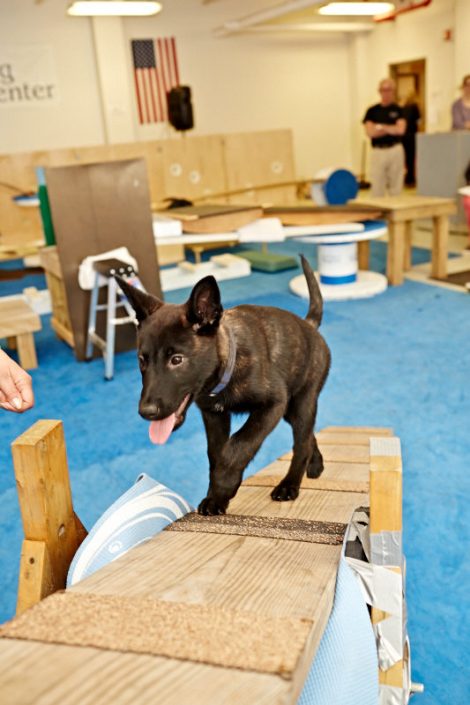

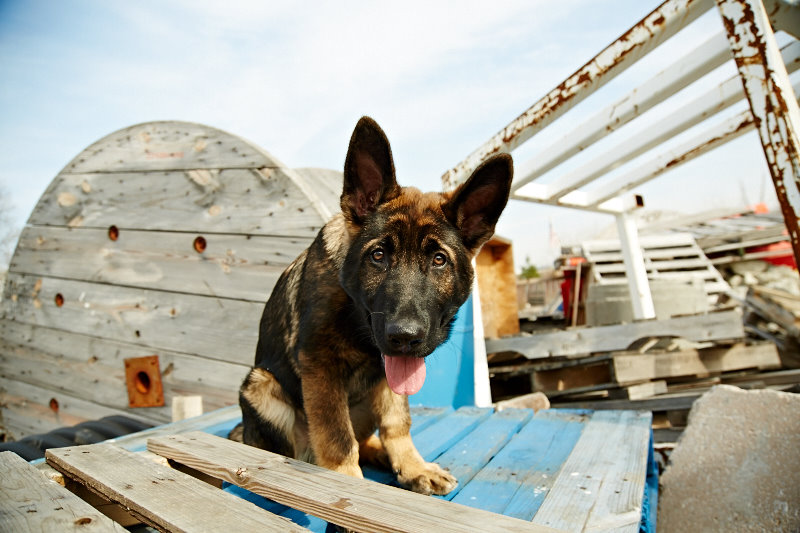



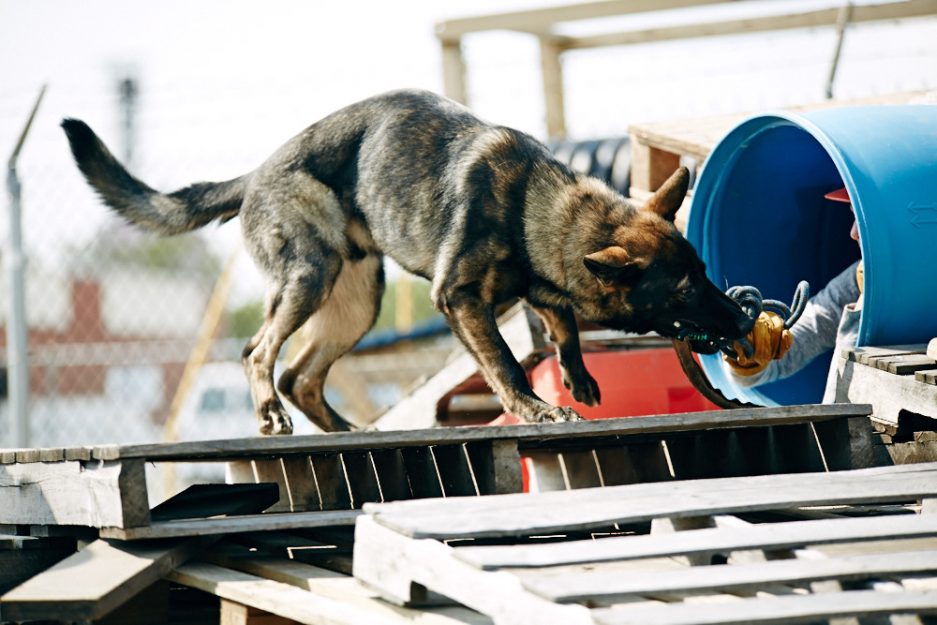

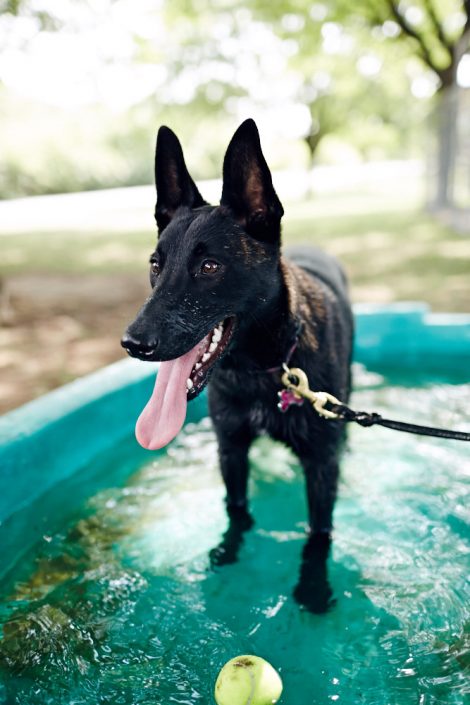

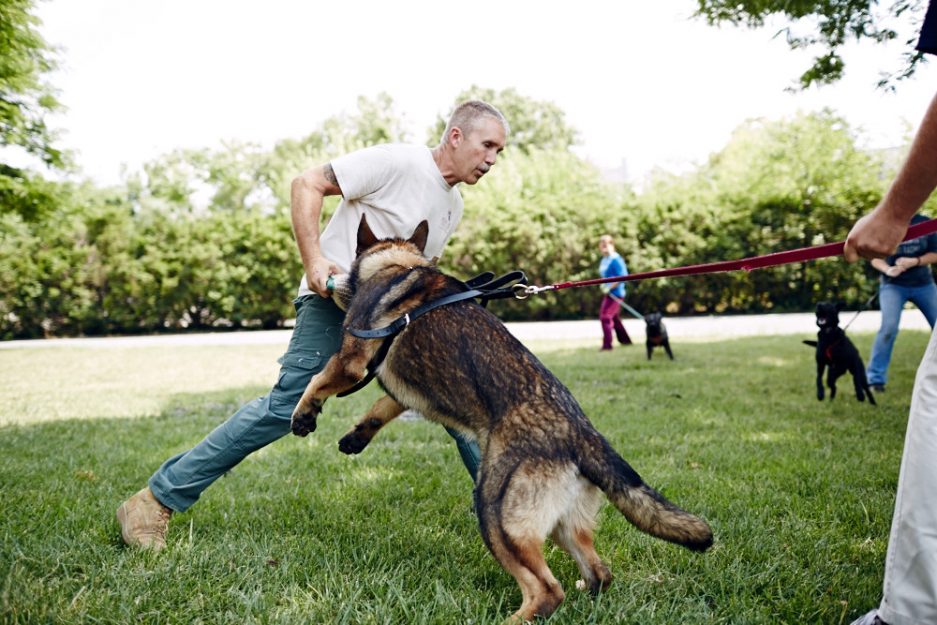

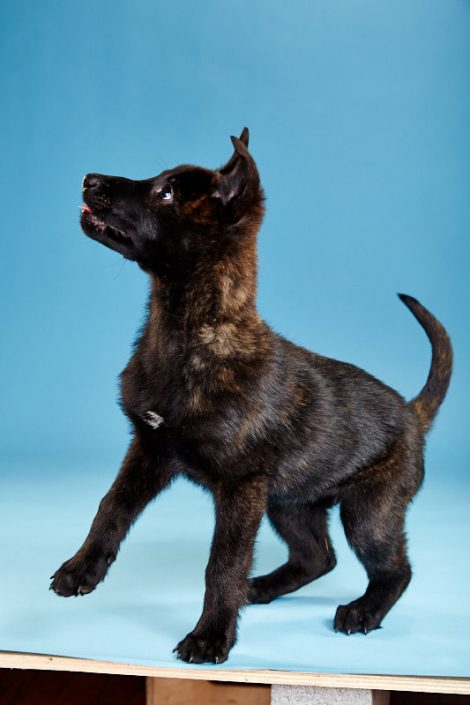

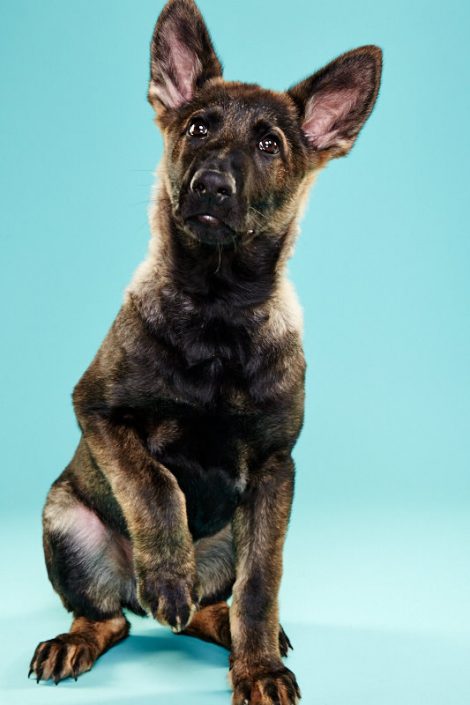

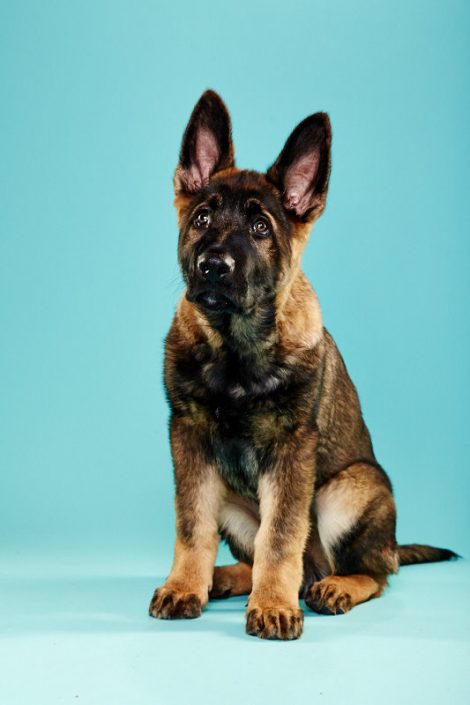

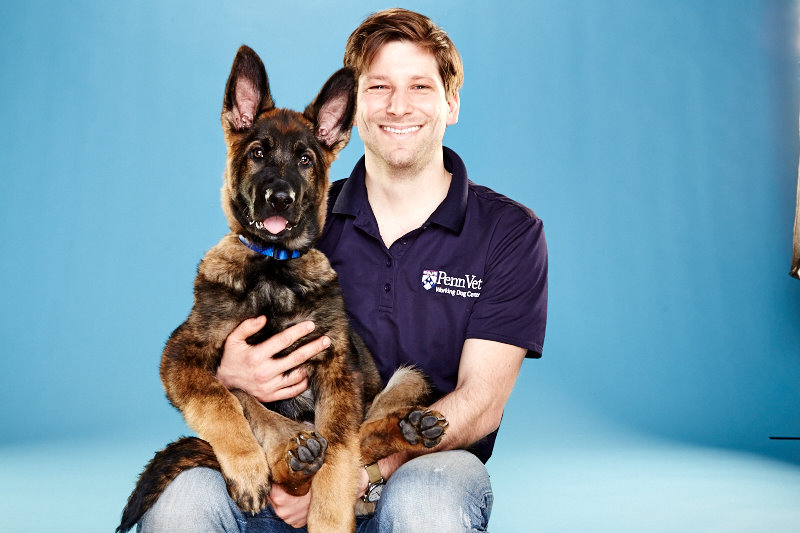

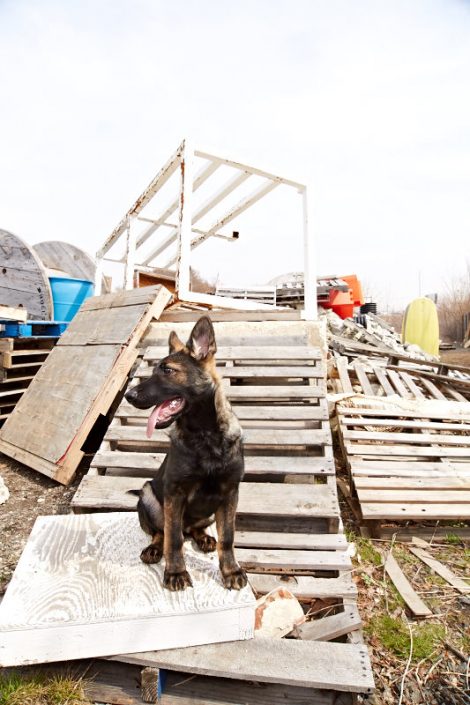

YOU COULD SAY the Working Dog Center is all about putting dogs where you don’t expect them.
The reception desk is along one side of a room filled with stuff your dog probably wouldn’t like. There’s a kiddie pool overflowing with noisy plastic water bottles. There are long, skinny balance beams, and those plastic tunnels kids play in, and metal grates, and ladders, and inclines, and pyramids of skids. There’s also Quest, a 10-week-old German shepherd being led through this maze by a volunteer. “We get them used to all sorts of scenarios,” Ashley says, “so they’re not afraid of heights or of walking on different surfaces.” There’s a second obstacle course outside, but it’s winter and the weather has been awful, so it’s closed for ice. Annemarie DeAngelo, the center’s head trainer, doesn’t take any chances with her charges. When Quest is ready to leave here, he’ll sell for as much as $10,000 — to FEMA, to a police department, to SEPTA, to the Department of Defense.
There’s a growing need in America for highly trained dogs, to detect explosives, to locate drugs, to find humans being smuggled across borders. Historically, working dogs have come to the U.S. from Eastern Europe, which has a long tradition of breeding and training. But demand has outstripped supply — and frankly, you can never be sure what you’re getting with a dog from overseas. This center, which opened on September 11, 2012, was founded to generate a homegrown, home-raised pipeline of canine excellence. There’s nothing else like it in the country.
It’s a peculiar mixture of science and joy, this place. Unlike most European trainers, Annemarie uses only positive reinforcement. Dogs aren’t scolded when they don’t do as they’re told, much less whacked with a rolled-up newspaper; they’re simply led through the task again. When they do successfully complete it, they’re showered with tsunamis of praise — most of it, since the trainers and volunteers are largely female, delivered at ear-shatteringly high pitch: “Oh, good puppy! What a smart puppy! What a superstar! Good dog!”
Balancing out the jubilation is academic rigor. Every moment of training is recorded with video cameras; results are analyzed and can be loaded onto iPads via specially designed apps that track how many reps it takes each dog to learn each step of each task from which trainer — as well as details like what distractions were present and what rewards (treats, tennis balls, tug toys) were used. The dogs — seven originally and 20 now, with the number still growing — are graded in obedience, agility, impulse control, sociability and fitness, to name just a few categories. Nutrition is carefully monitored; the dogs get supplements of fish oil and vitamins. There’s a Fecal Scoring System chart on the wall, so workers can assess — well, you know. Medical care is by Penn’s vet school, with which the center is affiliated. Above the dogs’ crates are chalkboards with notations like, “McBaine: Soft tissue injury. No running!” and “Great work with Sirius, Katie!”
The dogs are donated by breeders. Cindy Otto, the veterinarian who founded the center, is looking for a particular sort of puppy: “We want breeders who have paid exquisite attention to the dogs’ health, their parents’ health, their grandparents’ health.” She needs a certain temperament, a puppy who’s excited and enthusiastic but not reactive: “You want a dog that’s not afraid of different environments.” I wonder what the ear plug dispensers scattered throughout the center are for — until it’s midday and the dogs are served lunch, accompanied by a blizzard of recorded sirens and helicopters and emergency bleats and buzzes. The noise is so they’ll associate mayhem with getting fed.
Today, Logan and Quest, the newest puppies at the center, are being given their first lesson in search-and-rescue. Staff and volunteers load them and three older dogs, Thunder, Morgan and Pacy, into the center’s van for the short drive to a vacant building in the same industrial park as the center, near the Grays Ferry Bridge. Thunder, Pacy and Morgan are Labs — chocolate, black and yellow, respectively. Logan’s a German shepherd, the same age as Quest, less fluffy but no less cute.
One-year-old Thunder goes first. He already has a deposit down on him, for use in search-and-rescue. Among those on the scene, besides Annemarie, are training manager Pat Kaynaroglu; trainers Jonathan Ball and Katie Brennan; longtime volunteer Muhammed “Mo” Zaffa; another volunteer or two; and Ashley, whose mom happens to be the center’s volunteer coordinator. This is, in many ways, a family affair, even for the dogs. Quest comes from the same breeding line as Ronnie, a recent graduate who’s now working for SEPTA.
The abandoned building used to be a DuPont laboratory. The floors are wet; the rooms are void of furniture except for sinks and lab benches and countertops. We idle in a clump in a long hallway. Outside the front doors, Katie holds Thunder at the ready; Mo slips away from our group and hides. Annemarie says into her video recorder: “It’s February 24th, this is Thunder, building search.” Then she calls to Katie: “Let him go!”
Freed from his leash, Thunder barrels toward us, slipping and sliding across the wet floor. He bursts past us, reaches the end of the hallway, then turns around and busts it back, nails clicking furiously on concrete. This time around, he pauses at every doorway, nose down, sniffing, before taking off again.
What’s happening here is miraculous, if you think about it. As Thunder came roaring past us that first time in the hallway, he registered our scents — plus the scent of Mo, who was no longer there. The presence of the scent and absence of a person to match it were all he got to identify his quarry. And he won’t quit, won’t give up, until he tells us that quarry is at hand.
He locates Mo crouched behind a lab bench in a room halfway down the hallway and gives a series of barks: his signal to the handler. Mo comes out of hiding slapping a rope tug on the ground: “You found Mo! You found Mo! Good boy!” They engage in an enthusiastic tug-of-war. Then Mo gives the command for Thunder to drop the tug: “Out! Out!” Katie leashes the dog back up, and Mo takes off down the hall, out of sight. Annemarie retrieves the tug, grimacing at the drool that coats it. “Dog on-site!” she shouts, the video recorder running. Katie’s ready to release Thunder again. “Go find!” Annemarie commands.
Thunder takes off once more. Before we can trail him to the end of the hallway, he’s barking at the door behind which Mo is hidden. “Good boy! Good boy!” Mo tells the dog as he emerges, wrestling with him over another tug. Mo has a silver hoop in each ear, a grizzled beard, and thick gloves on his hands in case of accidental bites.
“Mo was the first volunteer to walk through our door,” Annemarie tells me. “Six-thirty in the morning the day we opened, he walks in and says, ‘I’m just here to volunteer.’” Since then, scores more have come — some for a semester while they study at Penn, some via vet-school internships, some just because they love dogs.
After half a dozen more rounds of hide-and-seek, Thunder goes back in the van, and the game is repeated with Morgan and Pacy. Then, “I want to see the babies,” says Annemarie — the brand-new pups, Logan and Quest.
The training starts out easy and gradually gets harder. In the beginning, the search is visual; soon after, the puppies will use scent. The insistence on positive reinforcement means the center can start training dogs at very young ages: “It’s all play,” says Pat, an easygoing search-and-rescue expert with white-blond hair. “If you were using pressure, you wouldn’t do that with babies. But it’s all a game to them.”
Logan is first up, a bundle of downy fur and too-big paws. Jonathan slaps a tug on the ground a few feet from the puppy’s nose, then backs away until he’s just out of sight beyond a doorway. Logan whimpers to be let loose to get his toy. “Go find!” Annemarie commands. Mo releases Logan, and he scampers through the door. Jonathan rewards him with the tug, and everyone showers him with accolades: “Great job, buddy! Good dog!”
The sequence is repeated, again and again, for 15 minutes or so — as long as a puppy Logan’s age can stay focused. The training will stretch out as he gets older. Each dog is different, but generally, the ones here train for 12 to 18 months before they’re sold.
It’s so cold we can see our breath, but nobody hurries to be done. “Some dogs would shut down under even this little bit of pressure,” Pat says, pleased with Logan’s performance. “This one already loves hunting.” Quest also acquits himself well. After his final find, Annemarie lets him keep the tug. He bears it proudly down the hallway, brimming with puppy swagger, tail flying like a flag.
DOGS WANT ONLY to please us. They get frustrated when they can’t. The dogs who gave Cindy Otto the idea for the Working Dog Center were frustrated.
On September 11, 2001, she was working at Penn’s veterinary hospital when she got a phone call. It was from Pennsylvania Task Force One, the state’s FEMA unit. They wanted Cindy to come to Ground Zero with the team to take care of their dogs.
For the next eight days, that’s what she did. Taking care of the dogs mostly meant telling the handlers, “This dog needs a break now.” Time was of the essence; everyone was desperate to find survivors in the rubble of the World Trade Center towers, and to do that, you needed the dogs. The canines were doing their job, trying as hard as they could, but after a day and a half, there were no more survivors. The dogs were conditioned to treat finding someone as a “win.” They were playing the game they loved over and over. But they never won.
Everyone at Ground Zero was tired and stressed and overworked. In the years since then, the men and women involved in the rescue effort — what was supposed to be a rescue effort — have developed a host of health problems, from respiratory illnesses to blood-cell cancers. Cindy performed a study of the health of the dozens of dogs who served. To her — to everyone’s — surprise, they’ve shown no ill effects.
The difference may be that dogs don’t do horror. To them, the loss of all those lives wasn’t a reason to grieve. After 9/11, there were rumors that the rescue dogs were “depressed” when they didn’t find survivors. They weren’t depressed, Cindy says. They were upset — but mostly because their handlers were.
Cindy isn’t big on anthropomorphism. Her center, the one she began thinking about in the darkness at Ground Zero and drew up out of whole cloth, is a highly practical place. Supported solely by donations and grants, it takes puppies eight weeks old — so small they can sit in your hand — and trains them to do the most dangerous jobs imaginable: find explosives, search for drugs, hunt down criminals, climb over earthquakes and mud slides to find the missing and maimed.
What qualifies a dog for this risky business is its nose. The canine nose is a wonder of adaptive evolution. We have six million olfactory receptors in our noses; dogs have 300 million. You might or might not notice if your morning coffee had an extra teaspoon of sugar in it. According to Nova, a dog’s power of smell can detect the equivalent of a teaspoon of sugar in a million gallons of water. A visual analogy: If you can see a tree that’s a third of a mile down the road, a dog can see that tree when it’s 3,000 miles away.
We breathe in and out, in and out, and while we’re breathing out, we’re not smelling. Not so dogs, whose nostrils are designed to provide intake even during exhalation, so they won’t lose a scent. Once air — and the scent molecules it bears — enters a human nose, it heads straight to the lungs, past a small scent-registering area atop the nasal cavity. In dogs, some 12 percent of air intake is detoured to a specialized region in the back of the nose, where it filters through a maze of bony “turbinates” that sift out the odor molecules according to their chemical properties. Olfactory receptors inside the turbinates’ lining register those molecules and send electrical signals announcing them to the olfactory bulb of the dog’s brain. From there, the signals are shunted to other regions that process emotions, memory and pleasure, according to veterinarian Randy Kidd, who writes that a simple smell detected by a dog “likely has an entire set of meanings, memories, and emotional ties that only that dog can know and interpret.” For pups, every breath is Proust.
Cindy Otto offers a spaghetti-sauce analogy: Where you and I smell a pot of gravy on the stove, a dog smells the tomatoes, the oregano, the onions, the celery … A dog with its head out a car window is on a hallucinogenic scent trip, assaulted by wave upon wave of odors. And though scientists are attempting to replicate this marvel of canine engineering, so far there’s nothing as good as what nature designed. (Generally speaking, the longer the snout, the better the scent-detection. The dogs at the center are mostly retrievers and shepherds. No pugs.)
But dogs don’t just locate felons and earthquake victims. Some of the pups at the center are being trained as diabetic alert dogs, on watch around the clock for scent changes in their owners that signify low blood sugar. Others, like Ohlin and McBaine — all the center’s dogs are named after 9/11 canine workers or victims — are taking part in a joint study with University City’s Monell Chemical Senses Center to identify ovarian cancer by scent. I get kind of excited at the prospect of finding a friendly Lab at my next ob-gyn appointment. Unfortunately, the dogs are only being used to identify the telltale chemical components; machines will test patient samples, if it gets to that.
Meantime, though, Jonathan shows me how these smell-centric puppies are trained. He’s made a special pair of cargo pants with dozens of pockets all around the legs — front, back, sides. In his hand he has a small metal vial; inside it is plasma from a donor with ovarian cancer. But it could be gunpowder or cocaine; the method’s the same. “Day one,” he says, “you hold out the tin and reward any sort of reaction” — with treats, praise, a tennis ball. “Then you really reward a sniff — ‘Yes!’ Then you raise the stakes higher and reward when you see the nose flare. You’re shaping her behavior. Then you add looking for it out of sight” — tucked in one of those many pockets. “You add an indicator — tapping the tin with a paw, or using a nose-poke.” He tells me to ask Annemarie about the music teacher and the drug-detection dog she once had.
“Most people who know me know what I do and know about my drug dogs,” Annemarie says. “But my music teacher didn’t know. He came to my house for a piano lesson. It was the first time he’d met Buddy, so he said, ‘Who’s that?’ ‘Oh, that’s my drug dog,’ I told him. He grabbed his coat, ran into the bathroom, and started flushing the toilet. He wasn’t even in there long enough to use it.”
All the dogs here are highly driven — as Cindy puts it, they have “the need to fetch the ball for the 67th time.” That’s the most vital personality trait. But they differ in other ways, and that’s how the trainers sort out who’s best suited to what job. The dogs that bounce off walls all day are great for search-and-rescue; the ones who’ll sit more quietly are steered to cancer detection or diabetic alert. Thanks to that meticulous breeding, no dogs wash out, except for one who had a health problem. But they do change over time. Just recently, Papa Bear, who’d been a diabetic alert dog, got moved over to search-and-rescue; as he got older, he grew more rambunctious. “With some, you know really young what they’re going to be good at,” Annemarie says. “With some of the others — some of the dogs that were at the bottom of the barrel when they started, one day a light just goes off. And sometimes I look at a dog and scratch my head and wonder: Where are you going to fit into this universe?”
Annemarie figured that out for herself early on. She was 16 when she saw a New Jersey state trooper by the side of the road: “I admired how he looked.” She entered the police academy a few years later and graduated at age 23, in 1980. She has a killer tan (“just on my face and arms”) and green eyes flecked with gold, and she carries herself like Elliot Stabler. She founded the state’s police canine program by herself, in 1987, buying a dog and going to school on her own time. The program started with three drug dogs; today there are dozens of canine teams statewide.
She’d put in more than 30 years and retired from the force when a dog-training friend who’d been with Cindy at Ground Zero called and told her about the vision for the center. “The next thing I knew,” she says, “I was no longer retired.” She gets up at 3:30 a.m. to drive in from her house in Central Jersey. More than anyone else here, she’s responsible for keeping the energy level up, for keeping things fun.
When she asks, on my second visit, for someone to “hide in the rubble pile,” vet student Andi Serrano quickly raises her hand. We all troop out to a stretch of land beside the river that’s been adorned with a vast mound of skids, crates, barrels, smashed-up concrete turnpike barriers, an old desk, even a wrecked car. It’s spring now, early April, with a blue sky and sunshine and a million things for a dog to smell. Annemarie has the video camera; Jonathan has Logan on a leash. They work on the “stay” command while we wait for Andi, beyond our view, to clamber into a crevice in the pile and close a sliding door.
Jonathan unleashes Logan, and Annemarie commands him: “Go find!” He’s come a long way in just six weeks; he scampers across the pile, clambering up and over and down, stopping, sniffing, until he halts atop a platform and barks at the door. Andi slides it back and greets him in triumph. “That was awesome!” Pat cries.
Donn Wagner, a sergeant in SEPTA’s K9 unit, where Quest’s brother Ronnie is assigned, says he’s worked with dogs before, but the center’s “are on a whole different level as far as training. They need fine polishing, but they have that solid foundation.” He acknowledges that the dogs are expensive, but says they’re “absolutely worth it”; their early start makes further training much easier. After the center, Ronnie went to explosive-detection school; this month, he starts 16 weeks of patrol training.
Ronnie was paid for with a grant from Homeland Security. A number of the center’s dogs have sales pending — to individual owners, in the case of diabetic alert dogs; to police departments; to federal and state search-and-rescue teams. The cancer-research dogs stay on at the center; Ovarian Cancer Symptom Awareness donates $10,000 each year to pay for Ohlin’s keep and training. The Chicago-based nonprofit features the handsome Lab prominently on its website and in fund-raising. Spokeswoman Vallie Syzmanski would love to fly him out for a PR visit: “But,” she says, laughing, “they say he’s working! He has a nine-to-five job!”
WHAT HAPPENS AFTER five — after the workday’s over — is the last piece of Cindy Otto’s vision. The lights in the center don’t go down, Madeline-style, on rows of dogs in metal crates. Instead, SUVs and Jeeps roll up to the parking lot for doggie pickup. The foster parents have arrived.
Nights and weekends, Logan and Quest and all the rest live in homes, with volunteers. They go for walks, romp in the yard, take trips to the grocery store. Sirius’s foster mom, Eileen Houseknecht, a research nurse at CHOP, has lived with him in her tiny Chestnut Hill apartment since she got him at eight weeks old.
“The first two weeks were tiring,” she says as we sit in her living room, the yellow Lab at our feet. “He didn’t sleep through the night. Once he got that down, and the potty training, we were good.” She crates him in her bedroom at night; they visit her parents and family — “He loves my brother” — and go walking and running on the trails in Wissahickon Valley Park. They take field trips; he loved the sand at the beach, and met what Eileen is convinced he thought was a giant dog at the Devon Horse Show. “He makes me laugh and smile every day,” she says. “He has an incredible personality.”
She grew up with dogs, but she works long hours and didn’t like the idea of leaving one home by itself all day. If she wants to go on vacation, the center arranges for an alternate foster. There are fitness and training classes — and a few restrictions. “They tell us not to take them to dog parks,” Eileen says, “which surprises a lot of people. But Dr. Otto says the Penn Vet emergency room is filled on weekends with dogs injured at dog parks.” The fosters don’t use electronic fences: “That’s not considered positive reinforcement.” Eileen isn’t supposed to feed Sirius table scraps or let him sleep with her in bed. “They want them to be dogs,” she says, “not people.”
Eileen knows, of course, that this dog isn’t really her dog. So does Bob Dougherty, a Cheltenham canine cop who’s fostering Felony, a dainty Dutch shepherd. Bob knew Annemarie from police work. After the center opened, she offered to show him around. “I told her I’d like to volunteer,” Bob says. “I didn’t think it would turn into what it has. But you just get sucked in.” He and his wife don’t have kids. Dogs help, he says: “It’s filled a gap that most humans have, a longing to take care of things.” Those gaps reopen when the dogs move on. “I know I won’t have him much longer,” Eileen says, stroking Sirius’s nose. “It’s hard. You bond with them. But I think he’s destined to do really great things.”
She shrugs. “We’re helping to raise dogs that are going to help other people. You do things for the greater good sometimes, right?”
THERE’S NO QUESTION these dogs love their work. Eileen says Sirius can hardly contain his excitement when she drops him off at the center each morning. No wonder; the mood here is so positive, so relentlessly upbeat, that it’s like living in Mr. Rogers’s Neighborhood. Sometimes you forget: These dogs will be sent onto battlefields to sniff for bombs; they’ll search for interlopers at border crossings. They’ll stare down the barrels of guns. They’ll do these things because to them it’s a game, and because they want to please their humans. But the bond goes both ways. “It’s more than companionship,” Bob Dougherty says of the working-dog relationship. “I’m with my police dog constantly — more than I see my wife most days. My canine partners rely on me, and I rely on them.”
What the center learns from the dogs is disseminated to trainers and breeders via academic papers, conferences, workshops, classes, its website. “We need research on how dogs behave so people can change the way they do things with dogs,” says Pat. She and Annemarie and Jonathan and the rest spend their days looking at dogs the way dogs look at people: with their heads half-cocked, wondering, “What now?”
Humans have long changed dogs; that’s how we wound up with toy poodles and pit bulls and Great Danes. But dogs change people, too. Jonathan was going to become a human doctor until his work with the puppies convinced him to apply to vet school. The center partners with nonprofits like New Leash on Life and Hand2Paws, helping convicts and homeless kids find self-discipline and purpose in the hard work of training. Mo had been sitting at home watching TV for two years, unable to work as a cook because of a seizure disorder, when he walked through the center’s door to volunteer. He’s been here ever since. “I love my dogs,” he says. “They’re all my favorites. Not one of them don’t know Mo.”
The next time I see the dogs, they’re on a field trip to Six Flags Great Adventure. It’s June, five days before the water park opens for the summer. Papa Bear, Felony, Quest and Logan are here, as is the newest baby, 10-week-old Osa. Also present: half a dozen handlers, and the golden retriever from the ladies’ room. Turns out he’s Prior, Annemarie’s current drug dog, who rides with her to the center from Jersey every day. He’s not a bathroom guard after all — he just doesn’t like being crated in the big room with the other dogs. But he loves the walks and ball-chasing and pats he gets from volunteers.
It’s the same routine here as back home: search-and-rescue, this time with the difficulty kicked up by the unfamiliar surroundings, hundreds of empty lounge chairs, a roofing crew atop a snack bar, a crowd of foreign teenagers taking lifeguarding tests, and a slew of groundskeepers armed with weed whackers and hedge shears. After their turns at hide-and-seek, the dogs get to learn to swim — or, more accurately, to discover that they know how to swim already — as the fully clad handlers lure them into a clear blue pool with tennis balls and tugs. Then everyone converges on a pirate-ship playground with slides leading into a splash pool, dogs and humans running and laughing and shouting and barking and splashing in the bright hot sun.
We’re a long way from Ground Zero. Still, Papa Bear and Quest and Logan look as much at home in the unnatural blue waters of Great Adventure as a Yorkie does in a Gucci bag. Thirty thousand years of mutual need and devotion have tangled the ties between dog and man beyond all unraveling. That first wolf-pup, wounded or frozen or starved, who crept timidly toward an outstretched hand — who’s to say that wasn’t where it belonged?
Originally published as “This Puppy Could Save Your Life” in the September 2014 issue of Philadelphia magazine.


